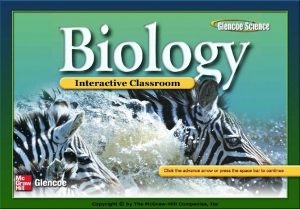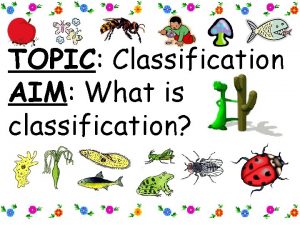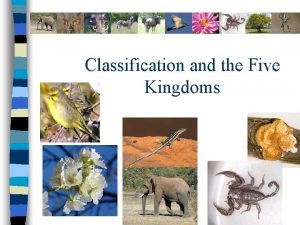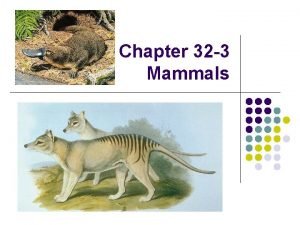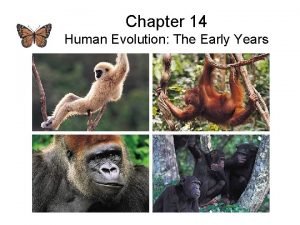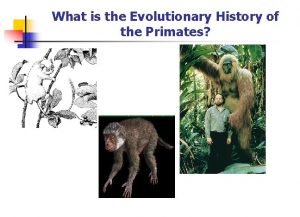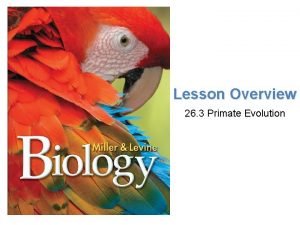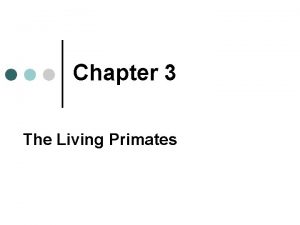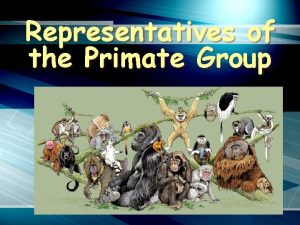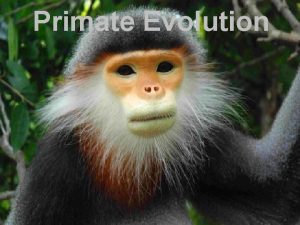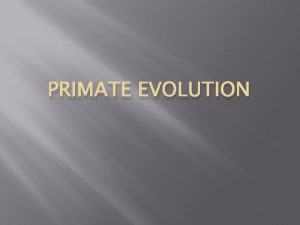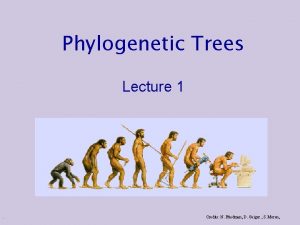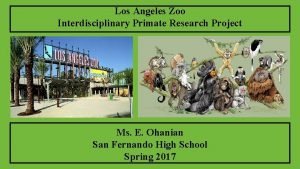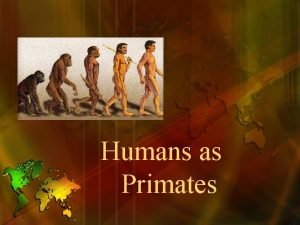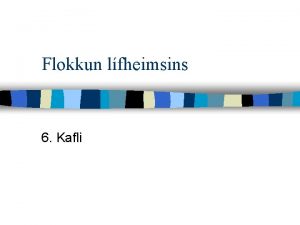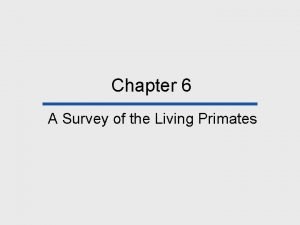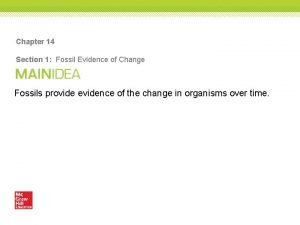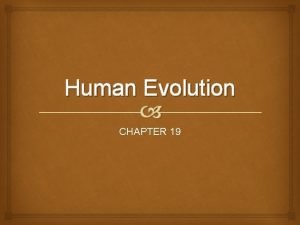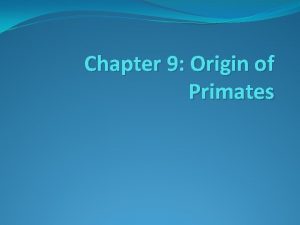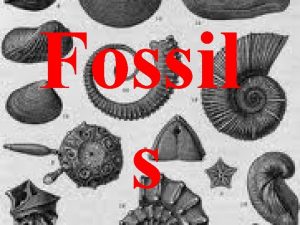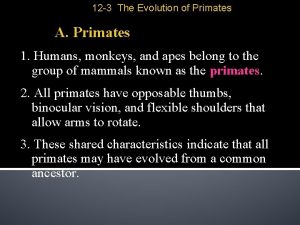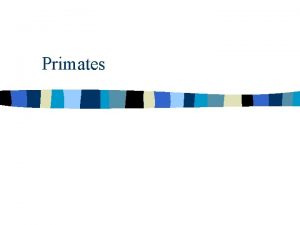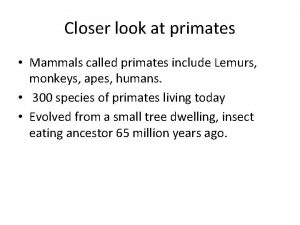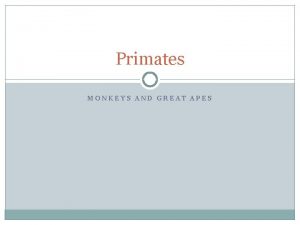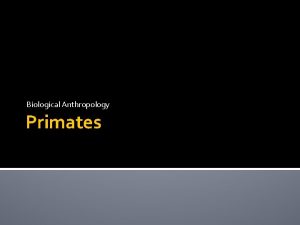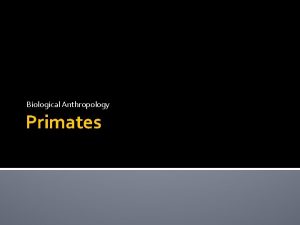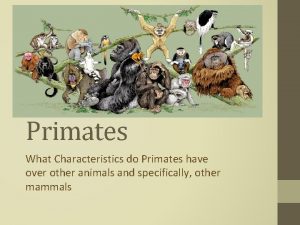Chapter 9 Overview of the Fossil Primates Chapter






















































- Slides: 54

Chapter 9 Overview of the Fossil Primates

Chapter Outline • • • Introduction Primate Origins Paleocene Primate-like Mammals Eocene Primates Oligocene Primates Miocene Primates

Orthograde • • An upright body position. This term relates to the position of the head and torso during sitting, climbing, etc. , and doesn’t necessarily mean an animal is bipedal.

Archonta • The superorder designated the sister orders of tree shrews, flying lemurs, plesiadapiforms, and primates.

Map Showing Location of the Fossil Primates

Map Showing Location of the Fossil Primates

Archonta • The superorder designated for the sister orders of tree shrews, flying lemurs, plesiadapiforms, and primates.

Seven Epochs of the Cenozoic • • Paleocene (65 mya; primate-like mammals, aka Plesiadapiformes) Eocene (55. 8 mya; first true primates, Prosimians) Oligocene (33 mya; early Catarrhines, precursors to monkeys and apes, emerge) Miocene (23 mya; monkeys and apes emerge, first humanlike creatures appear)

Seven Epochs of the Cenozoic • • • Pliocene (5. 3 mya; early humans diversify) Pleistocene (1. 8 mya; early Homo develops) Holocene (0. 01 mya; the present epoch)

Last Common Ancestor (LCA) • The final evolutionary link between two related groups.

Question • Monkeys, apes and the first humanlike creatures appeared during the: a) Pliocene. b) Eocene. c) Paleocene. d) Miocene.

Answer: d • Monkeys, apes and the first humanlike creatures appeared during the Miocene.

Carpolestes • Nearly complete skeleton of Carpolestes discovered in the Clarks Fork Basin of Wyoming. (a) Carpolestes as it was discovered. (b) Reconstructed skeleton (c) Artist’s rendering.

Eocene Primates • • Fossil primates from the Eocene display distinctive primate features. Looking at the whole array of Eocene primates, it is certain that they were: 1. Primates 2. Widely distributed 3. Mostly extinct by the end of the Eocene.

Teilhardina • • (a) View of the skull of Teilhardina from the top. (b) An artist’s reconstruction of Teilhardina, with areas in gray representing missing fragments.

Teilhardina • The rapid westward dispersal of euprimates of the genus Teilhardina.

Early Eocene Primates: Features • Chinese fossils dating from the early Eocene (55– 45 m. y. a. ) have three interesting features: -Forward rotation of the eyes makes them distinct from the lemur-loris lineage. -The cranium shows small eye sockets, suggesting they may have been diurnal. -They were all apparently extremely small, weighing less than 1 ounce.

Amphipithecids • The teeth of the amphipithecids are misleading, but the mandibles betray their phylogenetic affinity as lower primates.

Convergent Evolution • • An example of convergent evolution: the skull of Archaeolemur (left) and a macaque monkey. Note how the lemur resembles the monkey in the shape of the jaw, teeth, and overall cranial form.

Subfossil • Bone not old enough to have become completely mineralized as a fossil.

Bilophodonty • • Molars that have 4 cusps, oriented in 2 parallel rows, that resemble ridges or “lophs. ” This is characteristic of Old World Monkeys.

Paleoprimatologist • A person who specializes in the study of the nonhuman primate fossil record.

General Prosimian Characteristics 1. 2. 3. 4. 5. Smaller body size. Longer snouts with greater emphasis on smell. Eye sockets not completely enclosed in bone. Dental comb. Small simple premolars.

General Prosimian Characteristics 6. 7. 8. 9. 10. 11. Primitive triangle-shaped molars. Grooming claw. Artery running through the middle ear bone. Unfused mandible. Unfused frontal bone. Smaller brain size relative to body size.

General Anthropoid Characteristics 1. 2. 3. 4. 5. 6. Generally larger body size Shorter snouts with greater emphasis on vision Back of eye socket formed by bony plate Less specialized dentition, as seen in absence of dental comb and some other features Larger and more complex premolars Derived square-shaped molars with new cusp

General Anthropoid Characteristics 7. 8. 9. 10. 11. Nails instead of claws on all digits Loss of the artery running through the middle ear bone Fusion of the two sides of the mandible to form one bone Fusion of the two sides of the frontal bone Larger brain (in absolute terms and relative to body weight)

Catopithecus • • Three specimens of Catopithecus the earliest anthropoid genus to preserve a skull. These give us our first view of early catarrhine cranial anatomy including fully enclosed orbits.

Oligocene Primates • • • The Oligocene (34– 23 m. y. a. ) yielded fossil remains of several species of early anthropoids. By the early Oligocene, continental drift had separated the New World from the Old World. It has been suggested that late in the Eocene or very early in the Oligocene, the first anthropoids arose in Africa and reached South America by “rafting” over the water separation on drifting chunks of vegetation.

Phyletic Relationships of Fayum Early Anthropoids and Living Catarrhines

Parapithecus • Parapithecus belongs to the group of Fayum anthropoids that are most closely related to the ancestry of New World monkeys.

Aegyptopithecus • • Skull of Aegyptopithecus. This genus has been proposed as the ancestor of both Old World monkeys and hominoids.

Homunculus • Skull of Homunculus, a middle Miocene descendant of the earliest platyrrhine radiation.

Question • The majority of Old World primate fossils of the Oligocene epoch (33 -24 m. y. a) come from: a) China. b) the Fayum Depression in Egypt. c) East Africa. d) the Arabian Peninsula.

Answer: b • The majority of Old World primate fossils of the Oligocene epoch (33 -24 m. y. a) come from the Fayum Depression in Egypt.

Cladogram Of Extant Groups of New World Monkeys

Continental Relationships During the Late Eocene • The broken white line and surrounding shades of blue represent seafloor spreading, which caused continents to drift apart.

New World Monkey vs. Old World Monkey Characteristics New World Monkeys 1. Sideways facing nostrils 2. Ring-like ear hole with no tube 3. Dental formula of 2. 1. 3. 3 4. Grasping tail 5. Distribution: Mexico and South America Old World Monkeys 1. Downward facing nostrils 2. Tube-like ear hole 3. Dental formula of 2. 1. 2. 3 4. Ischial callosities 5. Distribution: Africa, southern Asia and Japan

Sister Group • • Two lineages that diverged from a particular common ancestor. Since sister groups share a common ancestor, they are each other’s closest relatives.

Victoriapithecus • Skull of Victoriapithecus, the first Old World monkey.

Theropithecus • • Skull of brumpti, the most bizarre fossil monkey (inset). An artist’s rendering of Theropithecus on the landscape in the Omo Basin of Ethiopia about 3 mya.

Comparison of Bilophodont Molars • • • Comparison of bilophodont molars as found in cercopithecoids and Y-5 molars as seen in hominoids. (a) Notice that the 4 cusps are positioned in 2 parallel rows or lobes. (b) See how the 5 cusps are arranged so that a Yshaped valley runs between them.

Y-5 Molar • • Molars that have 5 cusps with grooves running between them, forming a Y shape. This is characteristic of hominoids.

Dental Ape • An early ape that postcranially resembles a monkey, but dentally is hominoid (i. e. , has a Y-5 molar configuration).

Diversity of Early Miocene Ape Mandibles • • The shapes and sizes of these mandibles and teeth illustrates the adaptive diversity of apes during this time. They ranged in size from that of a male orangutan through half the size of a modern gibbon and ate foods as varied as hard roots and soft fruit.

Proconsul • Skull of Proconsul, the best known of the early Miocene dental apes.

Pliopithecus • • • Pliopithecus, from the middle Miocene of Europe. The pliopithecoids were the first catarrhines to leave Africa. Since this skull is of a female, no sagittal crest is present, though strong temporal lines indicate the individual enjoyed a diet of hard plant items.

Old World Monkey vs. Ape Characteristics Old World Monkey 1. Narrow nose and palate 2. Smaller brain 3. Bilophodont molars 4. Smaller average body size 5. Longer torso 6. Shorter arms 7. Tail Ape 1. Broad nose and palate 2. Even larger brain 3. Y-5 molars 4. Larger average body size 5. Shorter torso 6. Longer arms 7. No tail

Dryopithecus • • Skull of Dryopithecus, the earliest European ape. The left side is reconstructed as a mirror image of the complete right side.

Ouranopithecus • • Ouranopithecus, possible ancestor of the African apes. Notice that the face shares many features with living African great apes, including large browridges and a wide distance between the eye orbits.

Sagittal Crest • • A ridge of bone that runs down the middle of the cranium like a short Mohawk. This serves as the attachment for the large temporal muscles, indicating strong chewing.

Comparison of Chimpanzee, Sivapithecus and Orangutan • • Modern chimpanzee (left), Sivapithecus (middle), and modern orangutan (right). Sivapithecus and the orangutan exhibit a dished face, broad cheekbones, and projecting maxilla and incisors.

Gigantopithecus • An artist’s rendering of Gigantopithecus enjoying a meal of the tasty, but tough, tropical fruit known as durian.

Lufengpithecus • Skull of a Lufengpithecus juvenile from the late Miocene of Yunnan Province, China.

Biomolecular Primate Family Tree
 Chapter 16 primate evolution study guide answer key
Chapter 16 primate evolution study guide answer key Primate taxonomy upsc anthropology
Primate taxonomy upsc anthropology Cetacea canidae panacea ursidae primates
Cetacea canidae panacea ursidae primates Site:slidetodoc.com
Site:slidetodoc.com Animal pyramid kingdom
Animal pyramid kingdom Order primates
Order primates Evolution primates
Evolution primates Apidium dental formula
Apidium dental formula Why are there still apes if we evolved
Why are there still apes if we evolved Primates
Primates Espacio de deriva o leeway
Espacio de deriva o leeway Primates
Primates Q
Q Primate evolution
Primate evolution Haplorhines
Haplorhines Phylogenetic tree primates
Phylogenetic tree primates Old world monkeys
Old world monkeys Human evolution
Human evolution Augnglenna
Augnglenna Are raccoons primates
Are raccoons primates Chapter 14 section 1 fossil evidence of change answer key
Chapter 14 section 1 fossil evidence of change answer key Hát kết hợp bộ gõ cơ thể
Hát kết hợp bộ gõ cơ thể Slidetodoc
Slidetodoc Bổ thể
Bổ thể Tỉ lệ cơ thể trẻ em
Tỉ lệ cơ thể trẻ em Voi kéo gỗ như thế nào
Voi kéo gỗ như thế nào Tư thế worm breton
Tư thế worm breton Hát lên người ơi
Hát lên người ơi Các môn thể thao bắt đầu bằng từ đua
Các môn thể thao bắt đầu bằng từ đua Thế nào là hệ số cao nhất
Thế nào là hệ số cao nhất Các châu lục và đại dương trên thế giới
Các châu lục và đại dương trên thế giới Công thức tiính động năng
Công thức tiính động năng Trời xanh đây là của chúng ta thể thơ
Trời xanh đây là của chúng ta thể thơ Mật thư tọa độ 5x5
Mật thư tọa độ 5x5 Phép trừ bù
Phép trừ bù độ dài liên kết
độ dài liên kết Các châu lục và đại dương trên thế giới
Các châu lục và đại dương trên thế giới Thể thơ truyền thống
Thể thơ truyền thống Quá trình desamine hóa có thể tạo ra
Quá trình desamine hóa có thể tạo ra Một số thể thơ truyền thống
Một số thể thơ truyền thống Cái miệng nó xinh thế chỉ nói điều hay thôi
Cái miệng nó xinh thế chỉ nói điều hay thôi Vẽ hình chiếu vuông góc của vật thể sau
Vẽ hình chiếu vuông góc của vật thể sau Nguyên nhân của sự mỏi cơ sinh 8
Nguyên nhân của sự mỏi cơ sinh 8 đặc điểm cơ thể của người tối cổ
đặc điểm cơ thể của người tối cổ V. c c
V. c c Vẽ hình chiếu đứng bằng cạnh của vật thể
Vẽ hình chiếu đứng bằng cạnh của vật thể Fecboak
Fecboak Thẻ vin
Thẻ vin đại từ thay thế
đại từ thay thế điện thế nghỉ
điện thế nghỉ Tư thế ngồi viết
Tư thế ngồi viết Diễn thế sinh thái là
Diễn thế sinh thái là Dạng đột biến một nhiễm là
Dạng đột biến một nhiễm là Thế nào là số nguyên tố
Thế nào là số nguyên tố Tư thế ngồi viết
Tư thế ngồi viết
